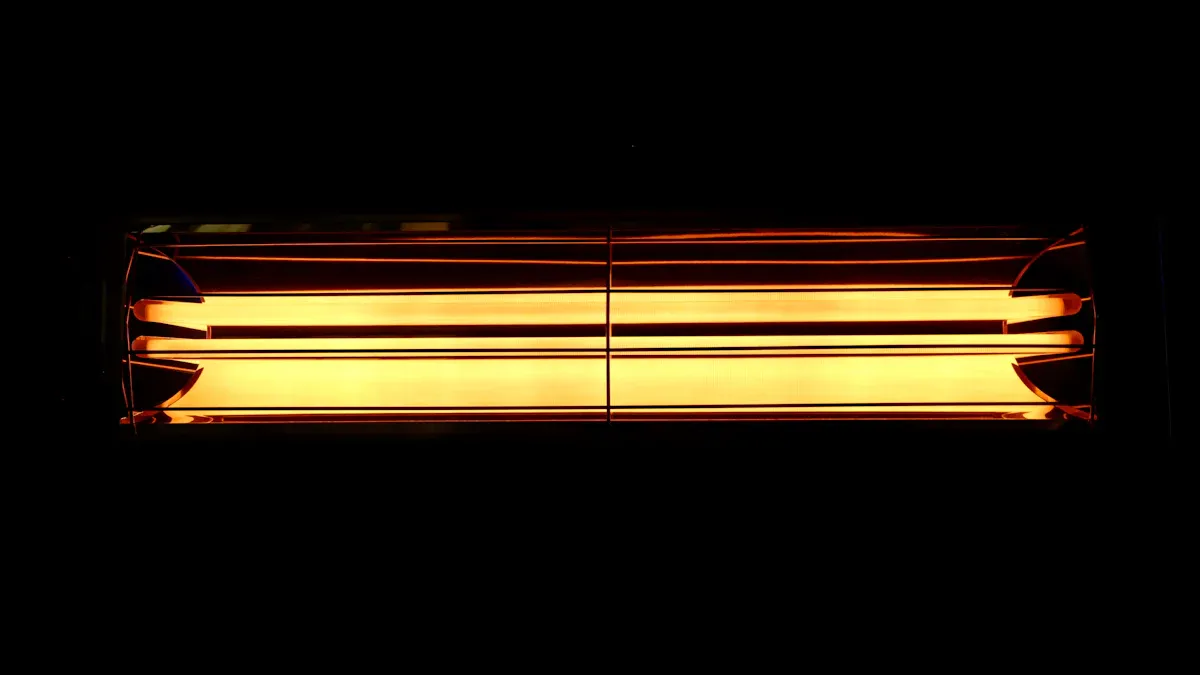
You rely on the нагревательный элемент inside your baseboard heater to deliver steady warmth on cold days. As a core component, it transforms electrical energy into heat, making your space comfortable. Электрическое отопление Цзиньчжун stands out among Производители нагревательных элементов for producing reliable нагревательные элементы бытовых приборов. A failed heating element leads to uneven temperatures and higher energy bills. Recognizing its role helps you maintain a safe and efficient home environment.
Understanding the Heating Element in Baseboard Heaters

Heating Element Definition
Что такое нагревательный элемент?
You find the heating element at the heart of every baseboard heater. This component generates heat that warms your room. Electric baseboard heaters use resistive coils, while hydronic models rely on pipes filled with hot water. The heating element transforms energy into warmth, making it essential for effective home heating.
Main Function in Baseboard Heaters
The heating element works with other parts to deliver consistent heat. Here is a breakdown of the main components that define a baseboard heater:
| Компонент | Описание |
|---|---|
| Нагревательный элемент | The core part that generates heat; electric systems use resistive elements, while hydronic systems use pipes filled with hot water. |
| Thermostat | Controls the heating system by monitoring room temperature and signaling the heating element to operate. |
| Baseboard Unit | Houses the heating element, typically made of metal, and installed along the floor to maximize heating efficiency. |
| Reflective Backing | Enhances efficiency by reflecting heat back into the room, minimizing heat loss. |
| Heat Distribution Fins | Increase surface area for heat transfer, ensuring even warmth throughout the room. |
| End Caps and Covers | Provide a finished look and protect the heating element from dust and debris, ensuring safety. |
You see how each part supports the heating element’s function and improves overall performance.
How the Heating Element Works
Simple Operation Explained
You activate the baseboard heater, and electricity flows through the heating element. The resistance in the coil causes energy loss, which appears as heat. This process, known as Joule heating, converts electrical energy into thermal energy. As electrons move through the coil, they collide with atoms, causing vibrations that produce heat.
- Electricity flows through the heating element, and resistance generates heat.
- Electron collisions with atoms in the coil transfer energy, causing vibrations and heat.
- Joule heating explains the conversion of electrical energy to thermal energy.
Heat Distribution Process
Once the heating element produces heat, the baseboard unit and heat distribution fins spread warmth throughout your room. The fins increase the surface area, allowing more heat to transfer into the air. Reflective backing pushes heat away from the wall and back into your living space. You benefit from even temperatures and improved comfort.
Tip: Position your baseboard heater along exterior walls to maximize heat distribution and reduce cold spots.
Importance of the Heating Element
Effect on Heating Performance
A well-maintained heating element ensures your baseboard heater operates efficiently. You experience optimal heat transfer and steady air circulation. If the heating element becomes dirty or damaged, you notice reduced heating performance and higher energy consumption. Regular inspection and cleaning help maintain efficiency.
- A clean heating element provides better heat transfer and air movement.
- Dirt or damage leads to lower performance and increased energy use.
Меры безопасности
You must pay attention to safety when using baseboard heaters. Malfunctioning heating elements can pose serious hazards. Placing flammable objects too close to the heater increases the risk of fire. Inspectors often cite baseboard heaters as fire hazards if combustible items are nearby. Both electric and hydronic heaters operate at temperatures that can affect surrounding materials.
- Baseboard heaters can cause fires if flammable items are placed too close.
- Inspectors may cite heaters as hazards when combustible objects are nearby.
- High operating temperatures make nearby materials vulnerable to heat exposure.
Note: Always keep furniture, curtains, and other flammable items at least several inches away from your baseboard heater.
Types of Heating Elements for Baseboard Heaters
Baseboard heaters use two main types of heating elements: electric convection and hydronic. You can see how they compare in the table below.
| Тип | Описание |
|---|---|
| Electric Convection | Uses electricity to warm air, creating a natural convection current for consistent room heating. |
| Hydronic | Utilizes hot water or oil for heating, generally more energy-efficient and retains heat longer. |
Электрический нагревательный элемент
How Electric Heating Elements Work
You find electric heating elements in many baseboard heaters. These elements use electricity to heat a metal coil or plate. When you turn on the heater, current flows through the coil. The coil resists the flow, which produces heat. The heated coil warms the air around it, and the warm air rises, creating a convection current that spreads heat throughout your room.
Materials used in electric heating elements include nickel-chromium alloys and iron-chromium-aluminum. Manufacturers often enclose the coil in a metallic sheath, such as steel or stainless steel, with magnesium oxide insulation for safety and durability.
| Тип материала | Описание |
|---|---|
| Alloys | Nickel-chromium, iron-chromium-aluminum, and refractory metals. |
| Sheathed Heaters | Heating coils enclosed in a metallic sheath with magnesium oxide insulation. |
| Sheath Materials | Steel, copper-coated steel, Incoloy®, Inconel®, and stainless steel. |
Pros and Cons of Electric Heating Elements
You benefit from simple installation and low maintenance with electric baseboard heaters. These heaters only need an electrical connection. You can expect a lifespan of от 3 до 10 лет for the heating element, depending on usage and care. With proper installation and regular cleaning, the entire heater may last up to 20 years.
Плюсы:
- Quick heating response
- Easy installation
- Low maintenance
Минусы:
- May use more energy in larger spaces
- Shorter heat retention compared to hydronic systems
Tip: Regular cleaning extends the lifespan of your electric heating element.
Hydronic Heating Element
How Hydronic Heating Elements Work
Hydronic baseboard heaters use a different approach. You rely on hot water or oil that circulates through pipes inside the heater. The liquid absorbs heat from a boiler or central system, then releases it slowly into your room. This process provides steady warmth and retains heat longer than electric coils.
Pros and Cons of Hydronic Heating Elements
Hydronic systems offer greater energy efficiency, especially in larger rooms. The liquid inside the pipes holds heat well, so the heater cycles on and off less often. You need to maintain the boiler and pumps regularly, which increases maintenance needs.
Плюсы:
- Excellent heat retention
- Lower energy consumption
- More efficient for large spaces
Минусы:
- More complex installation (requires plumbing)
- Higher maintenance due to boiler and pump servicing
Note: Hydronic heaters need regular checks to keep the system running smoothly.
Comparing Electric vs. Hydronic Heating Elements
Efficiency and Cost Comparison
You notice differences in efficiency and cost between electric and hydronic baseboard heaters. Hydronic units maintain warmth longer and use less energy over time. Electric heaters heat up faster but may cycle more often.
- Electric hydronic baseboard heaters keep rooms warm longer than standard electric heaters.
- Hydronic units use liquid to retain heat, resulting in lower energy consumption.
| Тип нагревателя | Average Installation Cost | Average Operating Cost (Monthly) |
|---|---|---|
| Electric | $400 – $650 | $50 – $60 |
| Hydronic | $450 – $700 | More efficient but requires a boiler |
Потребности в обслуживании
You spend less time maintaining electric baseboard heaters. Hydronic systems require more frequent checks and servicing of boilers and pumps. Electric heaters need only occasional cleaning and inspection.
Reminder: Choose a heating element based on your room size, budget, and willingness to perform regular maintenance.
Signs Your Heating Element Needs Attention
Common Symptoms of a Faulty Heating Element
No Heat or Low Heat Output
You may notice your baseboard heater fails to warm the room as expected. If you set the thermostat to a higher temperature but the heater does not respond, this often signals a problem. Sometimes, the heater produces only a small amount of warmth or none at all. Malfunctions in the thermostat can also cause improper temperature control. When your heater cannot reach the desired temperature, you should consider the possibility of a неисправный нагревательный элемент. Visible signs of damage or wear on the element itself serve as critical indicators that something is wrong.
Strange Noises or Smells
Unusual sounds, such as buzzing, popping, or clicking, can point to internal issues. These noises may result from loose connections or damaged components inside the heater. You might also detect odd smells, like burning dust or plastic. Persistent odors suggest overheating or electrical faults. If you notice these symptoms, turn off the heater and inspect it before further use.
Checking for Heating Element Problems
Этапы визуального осмотра
You can perform a basic inspection without special tools. Start by turning off the power to the heater. Once the unit cools, remove the cover and look for obvious signs of trouble.
- Осмотрите на предмет повреждений: Look for cracks, corrosion, or loose connections on the element.
- Ensure proper airflow: Make sure furniture or curtains do not block the heater.
- Check thermostat functionality: Confirm the thermostat senses room temperature accurately.
Tip: Always wait for the heater to cool before touching any internal parts.
Simple Testing Methods
You can test the heater’s function by adjusting the thermostat and observing the response. If the heater remains cold or heats unevenly, the element may have failed. For electric models, you may use a non-contact voltage tester to check for power at the terminals. If you feel unsure about electrical testing, stop and seek professional help.
Когда следует вызывать специалиста для решения проблем с нагревательным элементом
Риски безопасности
Attempting to repair a burnt-out heating element on your own can create safety hazards. You risk electrical shock or fire if you do not follow proper procedures. Overheating often points to wiring problems or component damage. These situations require immediate attention from a qualified technician.
Complex Problems
Some issues go beyond simple fixes. If you find persistent problems after basic checks, or if the heater trips circuit breakers, call a professional. Technicians have the expertise and tools to diagnose and repair complex faults safely.
Note: Professional service ensures your heater operates safely and efficiently.
How to Choose and Replace a Heating Element

Selecting the Right Heating Element
Matching Element Type to Heater Model
You need to match the replacement part to your specific baseboard heater model. Electric and hydronic heaters use different components, so always check your owner’s manual or the manufacturer’s label. If you feel uncertain, consult an HVAC professional. This step ensures you avoid compatibility issues and maintain safe operation.
When selecting a replacement, consider these factors:
- Efficiency and environmental impact
- Your budget for both purchase and long-term use
- Future property plans, such as renovations or upgrades
- Advice from HVAC professionals
- The installation process and safety requirements
Considering Wattage and Size
Choosing the correct wattage and size is essential for optimal performance. The wattage determines how much heat your unit can provide. If you select a unit that is too small, your room may feel cold and force you to raise the thermostat, which increases your energy bill. If you choose a unit that is too large, you may waste energy.
Follow these steps to estimate the right size:
- Measure your room’s length and width to find the square footage.
- Multiply the square footage by 10 watts if your home has good insulation.
- Adjust the wattage upward for high ceilings, poor insulation, or if the heater is your main heat source.
A 240V baseboard heater can deliver more power without overloading your circuits, making it a good choice for larger spaces.
Tip: Even heat distribution helps prevent cold spots and keeps your energy costs in check.
Safety Precautions for Heating Element Replacement
Turning Off Power or Water
Before you begin any work, always turn off the power supply at the breaker panel. For hydronic systems, shut off the water supply. Use a voltage tester to confirm that no electricity flows to the wires. This step protects you from electrical shock.
Using Proper Tools
Gather the right tools before starting. You may need a screwdriver, pliers, and a voltage tester. Inspect the wiring for damage or corrosion before you proceed. Make sure the new part matches your existing electrical circuit to prevent overloads.
Note: Safety comes first. Never skip these steps.
Step-by-Step Heating Element Replacement Guide
Извлечение старого нагревательного элемента
- Turn off the power or water supply.
- Remove the heater’s cover using a screwdriver.
- Disconnect the wiring or piping from the old element.
- Carefully slide out the old part.
Установка нового нагревательного элемента
- Insert the new part into the heater.
- Reconnect the wiring or piping, following the manufacturer’s instructions.
- Replace the cover and secure it.
- Restore power or water and test the heater for proper operation.
Callout: If you encounter any difficulties or notice damaged wiring, stop and contact a licensed technician.
When to Seek Help with Heating Element Replacement
Difficulties During Replacement
You may feel confident starting a heating element replacement, but certain challenges can quickly complicate the process. Some issues require specialized knowledge or tools that go beyond basic DIY skills. If you encounter any of the following problems, you should consider reaching out to a professional:
- Hot & Cold Spots: You might notice uneven heating after replacement. Blockages from clothes, draperies, or even dust can restrict airflow and create temperature inconsistencies. If you clear obstructions and still experience these issues, the problem may lie deeper within the system.
- Electrical Problems: Blown fuses or tripped breakers often signal underlying electrical faults. If you restore power and the heater still fails to operate, you risk electrical shock or further damage by continuing without proper expertise.
- Soot or Smoke Emissions: Dirt or debris on the heating element can burn, producing smoke or soot. If cleaning does not resolve the issue, internal damage may exist. Persistent emissions can also indicate a faulty installation or a compromised element.
- Inconsistent Temperatures: If your heater cannot maintain the set temperature, the internal thermostat or wiring may have issues. You may find that the heater cycles on and off unpredictably, which can reduce comfort and efficiency.
Совет: If you feel uncertain at any step or notice unusual symptoms, stop immediately. Safety should always come first.
You should also seek help if you encounter corroded wiring, damaged connectors, or if the replacement part does not fit your heater model. Attempting to force incompatible parts can lead to further complications or void your warranty.
Warranty and Support
You protect your investment by understanding your heater’s warranty and available support options. Most manufacturers offer warranties that cover defects in materials or workmanship. If you attempt a replacement yourself and damage the unit, you may void this coverage.
Before starting any repair, check your warranty documentation. Many brands require that a licensed technician perform repairs or replacements to maintain warranty validity. If your heater is still under warranty, contact the manufacturer or an authorized service provider for guidance.
| Warranty Aspect | Что нужно делать |
|---|---|
| Coverage Period | Verify if your heater is still covered. |
| Authorized Service | Use approved technicians for repairs. |
| Documentation Needed | Keep receipts and service records. |
Примечание: Manufacturer support teams can answer questions about compatible parts, installation procedures, and troubleshooting. You gain peace of mind and ensure safe operation by following their recommendations.
If you feel unsure about any part of the replacement process, professional help ensures your baseboard heater operates safely and efficiently.
Maintenance Tips for Heating Element Longevity
Regular Cleaning of Heating Elements
Dust and Debris Removal
Dust and debris can quickly accumulate on your baseboard heater, reducing efficiency and increasing fire risk. You should clean the outer surface regularly with a soft cloth or a vacuum cleaner attachment. For the interior, use a vacuum with a brush attachment to remove dust from the fins and hard-to-reach areas. A handheld steam cleaner can help loosen stubborn debris on the fins, but always lay down towels to absorb moisture and avoid direct contact with electrical components. Keeping your heater clean ensures optimal airflow and heat transfer.
Tip: Never use water or wet cloths directly on electrical parts. Always allow the unit to cool before cleaning.
Cleaning Schedule
Establishing a cleaning schedule helps you maintain consistent performance. Clean the outer surfaces at least once a month during the heating season. For a deeper clean, address the interior and fins every few months or at the start and end of each season. Regular cleaning not only extends the lifespan of your heating element but also keeps your home safer.
Inspection and Testing of Heating Elements
Checking for Wear and Tear
Routine inspections allow you to spot problems before they become serious. Look for visible damage, such as cracks, corrosion, or loose connections. Examine the wires and thermostat for signs of wear. Early detection of these issues helps you avoid costly repairs and maintain safe operation.
Simple Performance Checks
Вам следует implement a regular inspection and monitoring schedule. Weekly or monthly checks help you identify potential issues early. Test the heater by adjusting the thermostat and observing the response. If you notice uneven heating or the unit fails to turn on, further investigation may be necessary. Timely repairs ensure your heater remains efficient and safe.
- Inspect for visible damage or electrical faults.
- Test the thermostat calibration once a year using an independent thermometer.
- Ensure no furniture or curtains block airflow.
Preventing Common Heating Element Problems
Avoiding Overuse
Overusing your baseboard heater can shorten its lifespan. Set your thermostat to a reasonable temperature and avoid running the heater continuously. Use timers or programmable thermostats to manage heating cycles efficiently.
Monitoring for Early Warning Signs
Stay alert for early warning signs such as unusual noises, persistent odors, or inconsistent temperatures. Inspect electrical components annually and check for obstructions around the heater. Addressing these issues promptly reduces the likelihood of major problems and keeps your system running smoothly.
Note: Preventive maintenance, including regular cleaning and inspection, is the most effective way to protect your heating element and ensure reliable performance.
Safety and Efficiency Best Practices for Heating Elements
Safe Operation of Heating Elements
Keeping Flammable Items Away
You protect your home by keeping flammable items away from your baseboard heater. Place furniture, curtains, and other combustibles at least several inches from the unit. This simple step reduces fire risk and helps the heater work efficiently. You should also use baseboard heater covers to shield children and pets from hot surfaces. Regularly clean these covers to prevent dust buildup, which can lower efficiency and create hazards.
Совет: Always follow the manufacturer’s guidelines for safe clearance and operation.
Proper Use of Thermostats
You control room temperature and energy use with your thermostat. Set the thermostat to a comfortable level and avoid frequent adjustments. Use programmable or digital thermostats for better accuracy and efficiency. This practice prevents overheating and extends the life of your heating element. Schedule professional inspections to ensure your thermostat and heater work together safely.
- Use a thermostat to regulate temperature and avoid overheating.
- Schedule periodic inspections for safety and optimal performance.
- Educate family members about safe thermostat use.
Improving Heating Element Energy Efficiency
Using Timers and Controls
You can boost efficiency by installing timers or programmable thermostats. These devices let you set heating schedules that match your daily routine. Zone heating, where you only heat occupied rooms, saves energy and lowers costs. Choose digital controls for precise temperature management.
Insulation and Room Setup
You improve comfort and reduce energy loss by sealing drafts around windows and doors. Add insulation to walls and floors to keep heat inside. Arrange furniture to allow free airflow around the heater. Avoid blocking the unit with rugs or heavy drapes. Clean your baseboard heater regularly to ensure efficient heat transfer.
- Seal cracks and gaps to decrease drafts.
- Optimize insulation to prevent heat loss.
- Keep the area around the heater clear for proper airflow.
Примечание: Upgrading to energy-efficient models or hydronic systems can further reduce your energy bills.
Troubleshooting Heating Element Issues
Quick Fixes for Minor Problems
You can solve many minor issues with simple steps:
- Inspect connections and valves for leaks or loose fittings. Tighten as needed.
- Check for obstructions like furniture or curtains blocking the heater.
- Clean and straighten radiator fins with a vacuum brush or needle-nose pliers.
- Test the thermostat using a multimeter or follow your manual’s instructions.
- Bleed hydronic systems to remove airlocks and restore hot water flow.
These actions help restore performance and prevent bigger problems.
When to Upgrade Your Heating Element
You should consider an upgrade if you notice persistent issues, rising energy bills, or outdated equipment. Newer models offer better efficiency and safety features. Look for heaters with Energy Star certification or advanced controls. Consult a professional if you feel unsure about the best replacement for your home.
Regular maintenance and timely upgrades keep your heating system safe, efficient, and reliable.
You play a vital role in maintaining your baseboard heater’s performance and safety. Remember these key points:
- Power off the unit before cleaning or maintenance.
- Allow hydronic heaters to cool before servicing.
- Clean regularly to prevent dust buildup and improve efficiency.
- Keep the area around the heater clear of obstructions.
- Schedule annual inspections with a qualified technician.
Professional support ensures safe installation and reliable operation.
| Service Type | Выгода |
|---|---|
| Expert Wiring | Safe electrical connections |
| Annual Inspections | Early detection of potential issues |
| Timely Repairs | Prevents further damage |
Take action today to protect your comfort and safety.
ЧАСТО ЗАДАВАЕМЫЕ ВОПРОСЫ
What is the typical lifespan of a baseboard heater element?
You can expect most heating elements to last between 5 and 10 years. Lifespan depends on usage, maintenance, and the quality of the element. Regular cleaning and inspections help extend service life.
Can you replace a baseboard heater element yourself?
You may replace the element if you have basic electrical skills and follow safety precautions. Always turn off power or water before starting. If you feel unsure, contact a licensed technician for assistance.
How often should you clean your baseboard heater element?
You should clean the heater’s exterior monthly during the heating season. Deep clean the interior and fins every few months. Regular cleaning prevents dust buildup and improves efficiency.
What causes a baseboard heater element to fail?
You may encounter failure due to overheating, electrical faults, corrosion, or physical damage. Dust and debris also reduce performance. Routine maintenance helps prevent most common issues.
Is it safe to leave baseboard heaters on overnight?
You can leave baseboard heaters on overnight if you keep flammable items away and use a properly functioning thermostat. Always follow manufacturer safety guidelines to reduce fire risk.
Как узнать, что нагревательный элемент нуждается в замене?
You notice reduced heat output, strange noises, or persistent odors. Visual inspection may reveal damage or corrosion. If problems persist after cleaning, consider replacing the element.
Are hydronic baseboard heaters more energy-efficient than electric models?
Hydronic heaters retain heat longer and cycle less frequently. You benefit from lower energy consumption in larger spaces. Electric models heat up faster but may use more energy over time.
What wattage should you choose for your baseboard heater?
You calculate wattage by multiplying room square footage by 10. Adjust upward for poor insulation or high ceilings. Proper wattage ensures efficient heating and prevents energy waste.


